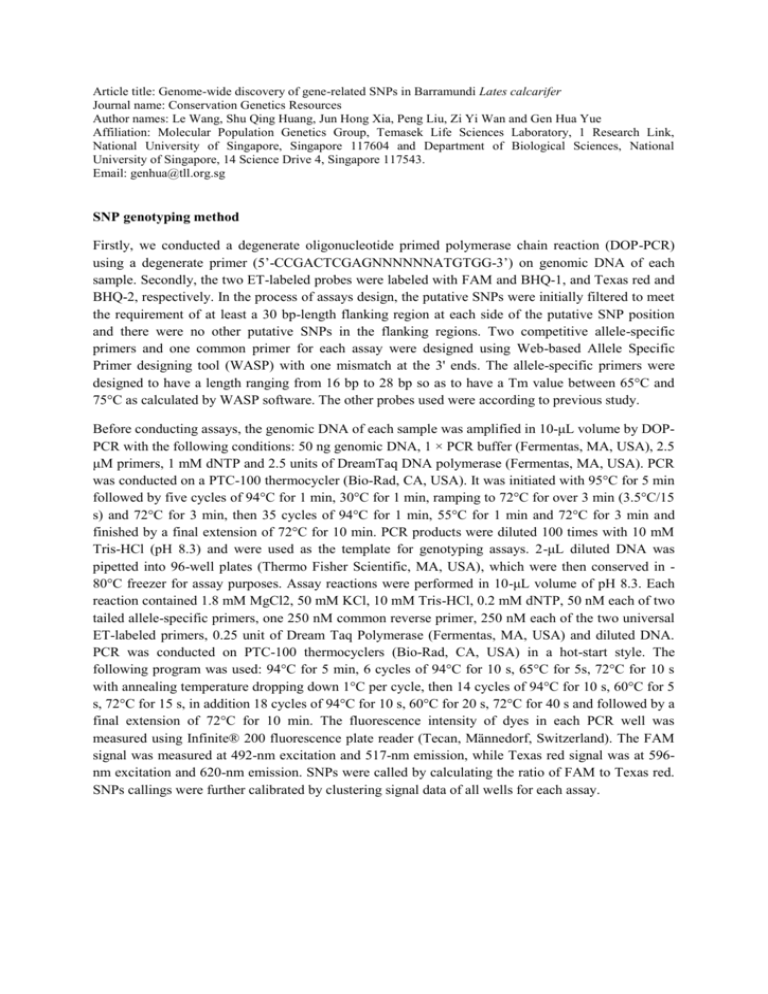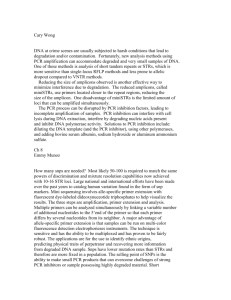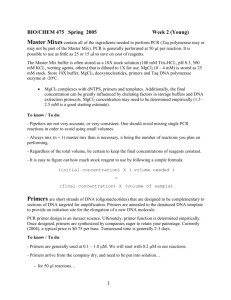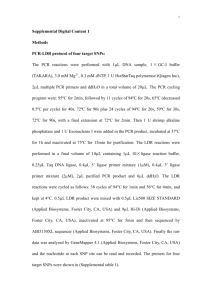Article title: Genome-wide discovery of gene
advertisement

Article title: Genome-wide discovery of gene-related SNPs in Barramundi Lates calcarifer Journal name: Conservation Genetics Resources Author names: Le Wang, Shu Qing Huang, Jun Hong Xia, Peng Liu, Zi Yi Wan and Gen Hua Yue Affiliation: Molecular Population Genetics Group, Temasek Life Sciences Laboratory, 1 Research Link, National University of Singapore, Singapore 117604 and Department of Biological Sciences, National University of Singapore, 14 Science Drive 4, Singapore 117543. Email: genhua@tll.org.sg SNP genotyping method Firstly, we conducted a degenerate oligonucleotide primed polymerase chain reaction (DOP-PCR) using a degenerate primer (5’-CCGACTCGAGNNNNNNATGTGG-3’) on genomic DNA of each sample. Secondly, the two ET-labeled probes were labeled with FAM and BHQ-1, and Texas red and BHQ-2, respectively. In the process of assays design, the putative SNPs were initially filtered to meet the requirement of at least a 30 bp-length flanking region at each side of the putative SNP position and there were no other putative SNPs in the flanking regions. Two competitive allele-specific primers and one common primer for each assay were designed using Web-based Allele Specific Primer designing tool (WASP) with one mismatch at the 3' ends. The allele-specific primers were designed to have a length ranging from 16 bp to 28 bp so as to have a Tm value between 65°C and 75°C as calculated by WASP software. The other probes used were according to previous study. Before conducting assays, the genomic DNA of each sample was amplified in 10-μL volume by DOPPCR with the following conditions: 50 ng genomic DNA, 1 × PCR buffer (Fermentas, MA, USA), 2.5 μM primers, 1 mM dNTP and 2.5 units of DreamTaq DNA polymerase (Fermentas, MA, USA). PCR was conducted on a PTC-100 thermocycler (Bio-Rad, CA, USA). It was initiated with 95°C for 5 min followed by five cycles of 94°C for 1 min, 30°C for 1 min, ramping to 72°C for over 3 min (3.5°C/15 s) and 72°C for 3 min, then 35 cycles of 94°C for 1 min, 55°C for 1 min and 72°C for 3 min and finished by a final extension of 72°C for 10 min. PCR products were diluted 100 times with 10 mM Tris-HCl (pH 8.3) and were used as the template for genotyping assays. 2-μL diluted DNA was pipetted into 96-well plates (Thermo Fisher Scientific, MA, USA), which were then conserved in 80°C freezer for assay purposes. Assay reactions were performed in 10-μL volume of pH 8.3. Each reaction contained 1.8 mM MgCl2, 50 mM KCl, 10 mM Tris-HCl, 0.2 mM dNTP, 50 nM each of two tailed allele-specific primers, one 250 nM common reverse primer, 250 nM each of the two universal ET-labeled primers, 0.25 unit of Dream Taq Polymerase (Fermentas, MA, USA) and diluted DNA. PCR was conducted on PTC-100 thermocyclers (Bio-Rad, CA, USA) in a hot-start style. The following program was used: 94°C for 5 min, 6 cycles of 94°C for 10 s, 65°C for 5s, 72°C for 10 s with annealing temperature dropping down 1°C per cycle, then 14 cycles of 94°C for 10 s, 60°C for 5 s, 72°C for 15 s, in addition 18 cycles of 94°C for 10 s, 60°C for 20 s, 72°C for 40 s and followed by a final extension of 72°C for 10 min. The fluorescence intensity of dyes in each PCR well was measured using Infinite® 200 fluorescence plate reader (Tecan, Männedorf, Switzerland). The FAM signal was measured at 492-nm excitation and 517-nm emission, while Texas red signal was at 596nm excitation and 620-nm emission. SNPs were called by calculating the ratio of FAM to Texas red. SNPs callings were further calibrated by clustering signal data of all wells for each assay.











